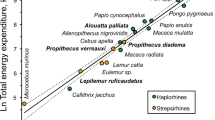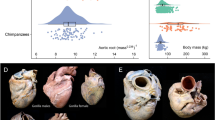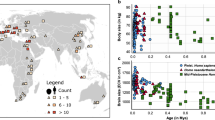Abstract
Humans are distinguished from the other living apes in having larger brains and an unusual life history that combines high reproductive output with slow childhood growth and exceptional longevity1. This suite of derived traits suggests major changes in energy expenditure and allocation in the human lineage, but direct measures of human and ape metabolism are needed to compare evolved energy strategies among hominoids. Here we used doubly labelled water measurements of total energy expenditure (TEE; kcal day−1) in humans, chimpanzees, bonobos, gorillas and orangutans to test the hypothesis that the human lineage has experienced an acceleration in metabolic rate, providing energy for larger brains and faster reproduction without sacrificing maintenance and longevity. In multivariate regressions including body size and physical activity, human TEE exceeded that of chimpanzees and bonobos, gorillas and orangutans by approximately 400, 635 and 820 kcal day−1, respectively, readily accommodating the cost of humans’ greater brain size and reproductive output. Much of the increase in TEE is attributable to humans’ greater basal metabolic rate (kcal day−1), indicating increased organ metabolic activity. Humans also had the greatest body fat percentage. An increased metabolic rate, along with changes in energy allocation, was crucial in the evolution of human brain size and life history.
This is a preview of subscription content, access via your institution
Access options
Subscribe to this journal
Receive 51 print issues and online access
$199.00 per year
only $3.90 per issue
Buy this article
- Purchase on Springer Link
- Instant access to full article PDF
Prices may be subject to local taxes which are calculated during checkout


Similar content being viewed by others
References
Isler, K. & van Schaik, C. P. How our ancestors broke through the gray ceiling. Curr. Anthropol. 53, S453–S465 (2012)
Charnov, E. L. Life History Invariants (Oxford Univ. Press, 1993)
Brown, J. H., Gillooly, J. F., Allen, A. P., Savage, V. M. & West, B. G. Toward a metabolic theory of ecology. Ecology 85, 1771–1789 (2004)
Stearns, S. C. The Evolution of Life Histories (Oxford Univ. Press, 1992)
Charnov, E. L. The optimal balance between growth rate and survival in mammals. Evol. Ecol. Res. 6, 307–313 (2004)
Charnov, E. L. & Berrigan, D. Why do primates have such long life spans and so few babies? Evol. Anthropol. 1, 191–194 (1993)
Isler, K. & van Schaik, C. P. The Expensive Brain: a framework for explaining evolutionary changes in brain size. J. Hum. Evol. 57, 392–400 (2009)
Aiello, L. C. & Wheeler, P. The expensive tissue hypothesis. Curr. Anthropol. 36, 199–221 (1995)
Navarrete, A., van Schaik, C. P. & Isler, K. Energetics and the evolution of human brain size. Nature 480, 91–93 (2011)
Pontzer, H., Raichlen, D. A. & Rodman, P. S. Bipedal and quadrupedal locomotion in chimpanzees. J. Hum. Evol. 66, 64–82 (2014)
Leonard, W. R. & Robertson, M. L. Comparative primate energetics and hominid evolution. Am. J. Phys. Anthropol. 102, 265–281 (1997)
Speakman, J. R. Doubly Labelled Water: Theory & Practice (Chapman & Hall, 1997)
Pontzer, H. et al. Constrained total energy expenditure and metabolic adaptation to physical activity in adult humans. Curr. Biol. 26, 410–417 (2016)
Butte, N. F. Fat intake of children in relation to energy requirements. Am. J. Clin. Nutr. 72 (suppl.), 1246S–1252S (2000)
Bruhn, J. M. & Benedict, F. G. The respiratory metabolism of the chimpanzee. Proc. Am. Acad. Arts Sci. 71, 259–326 (1936)
Bruhn, J. M. The respiratory metabolism of infrahuman primates. Am. J. Physiol. 110, 477–484 (1934)
Pontzer, H., Raichlen, D. A., Shumaker, R. W., Ocobock, C. & Wich, S. A. Metabolic adaptation for low energy throughput in orangutans. Proc. Natl Acad. Sci. USA 107, 14048–14052 (2010)
Zihlman, A. L. & Bolter, D. R. Body composition in Pan paniscus compared with Homo sapiens has implications for changes during human evolution. Proc. Natl Acad. Sci. USA 112, 7466–7471 (2015)
Pontzer, H. et al. Hunter-gatherer energetics and human obesity. PLoS ONE 7, e40503 (2012)
Wang, Z., Bosy-Westphal, A., Schautz, B. & Müller, M. Mechanistic model of mass-specific basal metabolic rate: evaluation in healthy young adults. Int. J. Body Compos. Res. 9, 147 (2011)
Bauernfeind, A. L. et al. Evolutionary divergence of gene and protein expression in the brains of humans and chimpanzees. Genome Biol. Evol. 7, 2276–2288 (2015)
Pontzer, H. Constrained total energy expenditure and the evolutionary biology of energy balance. Exerc. Sport Sci. Rev. 43, 110–116 (2015)
Pontzer, H. et al. Primate energy expenditure and life history. Proc. Natl Acad. Sci. USA 111, 1433–1437 (2014)
Nie, Y. et al. Exceptionally low daily energy expenditure in the bamboo-eating giant panda. Science 349, 171–174 (2015)
Carmody, R. N., Weintraub, G. S. & Wrangham, R. W. Energetic consequences of thermal and nonthermal food processing. Proc. Natl Acad. Sci. USA 108, 19199–19203 (2011)
R Core Team. R: A language and environment for statistical computing. (R Foundation for Statistical Computing. Vienna, Austria, 2013)
Henry, C. J. Basal metabolic rate studies in humans: measurement and development of new equations. Public Health Nutr. 8, 1133–1152 (2005)
Acknowledgements
We thank participating zoos and staff for their efforts: Houston Zoo, Indianapolis Zoo, Jacksonville Zoo, Lincoln Park Zoo, Milwaukee County Zoo, North Carolina Zoo, Oklahoma City Zoo, Oregon Zoo, Zoo Atlanta, Woodland Park Zoo, Dallas Zoo, Brookfield Zoo and Columbus Zoo. We thank B. Moumbaka for assistance administering doses and collecting samples for analysis. We thank R. Atencia and C. Andre for supporting this project. Work at Tchimpounga and Lola Ya Bonobo was performed under the authority of the Ministry of Research and the Ministry of Environment in the Democratic Republic of Congo (research permit #MIN.RS/SG/004/ 2009) and the Ministry of Scientific Research and Technical Innovation in the Congo Republic (research permit 09/MRS/DGRST/ DMAST), with samples imported under CITES permits 09US223466/9 and 9US207589/9. L. Christopher, K. Stafford and J. Paltan assisted with sample analyses. Funding was provided by the US National Science Foundation (BCS-1317170), National Institutes of Health (R01DK080763), L.S.B. Leakey Foundation, Wenner-Gren Foundation (Gr. 8670), University of Arizona and Hunter College.
Author information
Authors and Affiliations
Contributions
H.P. and S.R.R. designed the study; H.P., M.H.B., D.A.R., H.D., B.H., K.W., A.L., L.R.D., J.P.-R., P.B., T.E.F., E.V.L., R.W.S. and S.R.R. collected data; H.P., R.D.-A., M.E.T. and D.S. analysed data. All authors contributed to writing the manuscript.
Corresponding author
Ethics declarations
Competing interests
The authors declare no competing financial interests.
Extended data figures and tables
Extended Data Figure 1 The human energetic paradox.
Humans achieve greater reproductive output (g year−1; black bar) and have larger brains (g; blue bar) relative to female metabolic mass (kg0.75) than any of the great apes, yet also achieve longer lifespans (grey bar). Human data are from traditional hunter–gatherer and subsistence farming populations; ape data are from populations in the wild1 (see Supplementary Table 2).
Extended Data Figure 2 BMRs for humans, chimpanzees and orangutans.
Available BMR data for chimpanzees15,16 are primarily from juveniles (age: 2 months to 15 years), and are shown here against comparably aged humans14 (3–18 years). Humans have greater BMRs than chimpanzees in a general linear model of ln-transformed BMR and mass controlling for age and sex (P < 0.001; Supplementary Table 3). Note that in humans (but not chimpanzees), males have greater BMRs for a given body mass, reflecting their greater proportion of FFM (that is, lower body fat percentage). The available data for orangutan BMR consists of one juvenile individual16 (no age reported, mass 16.2 kg). Resting metabolic rates (RMRs; kcal day−1), measured in alert orangutans while sitting17, are also shown. The top of the bar indicates the measured RMR for those individuals, and the bottom square indicates estimated BMR based on those measurements17, assuming BMR = 0.8RMR. No BMR data are available for gorillas. Symbols marked with black circles are males. Allometric regressions shown for Pan (y = 100.17x0.65) and Pongo (y = 218.61x0.37) and were used to estimate BMR for the adult cohorts in Table 1. Human BMR in Table 1 was estimated from published, sex-specific predictive equations for adults27.
Supplementary information
Supplementary Information
This file contains Supplementary Text and Data, Supplementary Tables 1-3, Supplementary Figures 1-2 and additional references. (PDF 444 kb)
PowerPoint slides
Rights and permissions
About this article
Cite this article
Pontzer, H., Brown, M., Raichlen, D. et al. Metabolic acceleration and the evolution of human brain size and life history. Nature 533, 390–392 (2016). https://doi.org/10.1038/nature17654
Received:
Accepted:
Published:
Issue Date:
DOI: https://doi.org/10.1038/nature17654
This article is cited by
-
Impact of energy availability and physical activity on variation in fertility across human populations
Journal of Physiological Anthropology (2023)
-
The aorta in humans and African great apes, and cardiac output and metabolic levels in human evolution
Scientific Reports (2023)
-
Genetics of sexually dimorphic adipose distribution in humans
Nature Genetics (2023)
-
From fossils to mind
Communications Biology (2023)
-
Fatty acids fuelling astroglia and beyond
Nature Metabolism (2023)
Comments
By submitting a comment you agree to abide by our Terms and Community Guidelines. If you find something abusive or that does not comply with our terms or guidelines please flag it as inappropriate.



